The Department of Transportation (DOT) is reviewing its existing policy statements, guidance documents, and regulations to identify unnecessary obstacles to transportation infrastructure projects. As part of this review, the Department invites affected stakeholders and the public to identify non-statutory requirements that the Department imposes and that should be removed or revised.
View this complete post...Posts Tagged ‘DOT’
Transportation Infrastructure: Notice of Review of Policy, Guidance, and Regulation
Wednesday, June 14th, 2017Bike-Share Stations in the U.S.
Friday, April 8th, 2016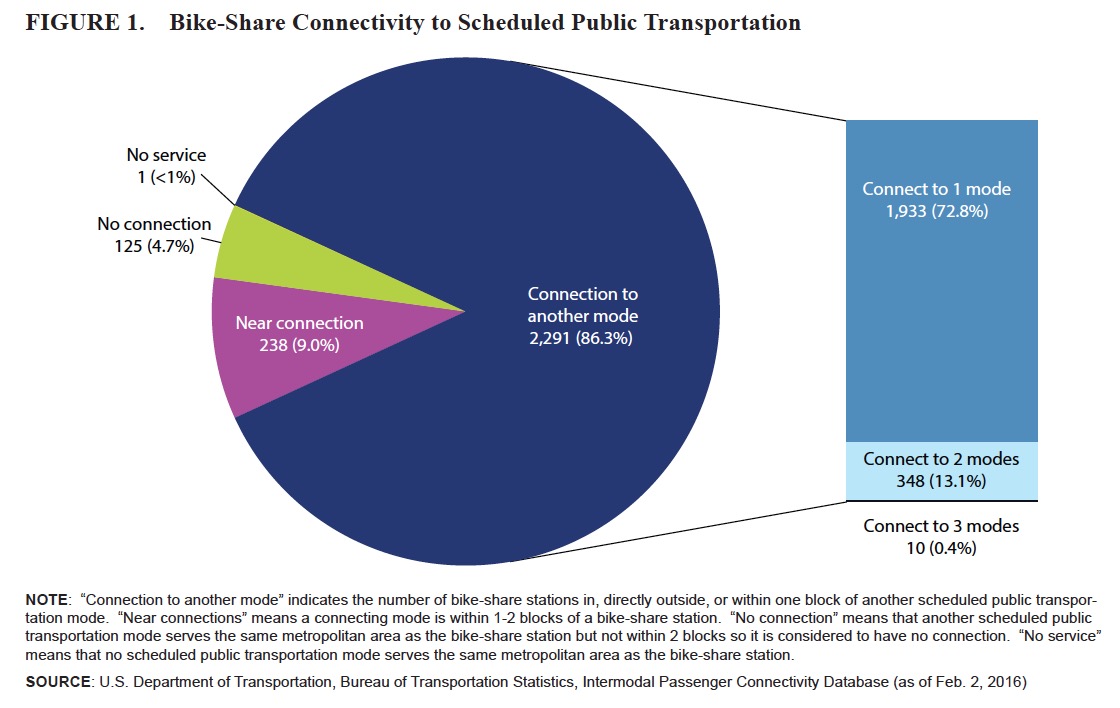
U.S. DEPARTMENT OF TRANSPORTATION
BUREAU OF TRANSPORTATION STATISTICS
Bike-share systems typically operate independently of local transit authorities. However, most bike-share docking stations (86.3 percent) can be found near local public transportation stops (transit bus, commuter rail, heavy rail, light rail, and transit ferry). These locations offer modal choice and the opportunity to connect between modes. Transit bus is the most typical connection, with 84.2 percent (2,236) of bike-share stations located a block or less from a transit bus stop.
The Innovative DOT: Focus Area 1 – Revenue Sources
Tuesday, January 13th, 2015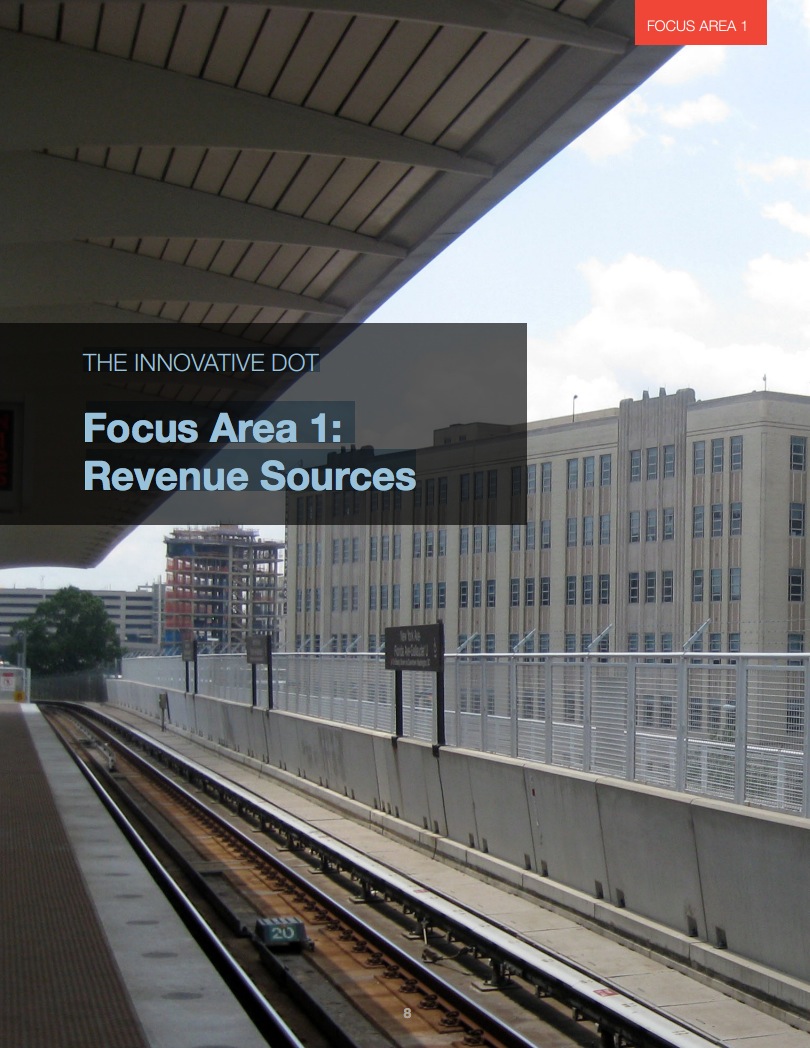
The era when fuel taxes alone could cover robust highway construction and maintenance programs is over. Even then, non-highway modes often struggled for support. Funding transportation out of general revenue is problematic, both be-cause it is subject to changing budget priorities and because it underprices transportation, creating excess demand. State departments of transportation (DOTs) need new sources of dedicated revenues, preferably tied to user fees in cases where excess demand—which is both economically and environmentally costly—can be curtailed through the market-style discipline that such fees impose. User fees may also appeal to stakeholders’ sense of fairness, making them more politically palatable than “subsidies” from general tax revenues.
View this complete post...Now Accepting Entries: U.S. DOT’s Data Innovation Challenge
Wednesday, February 26th, 2014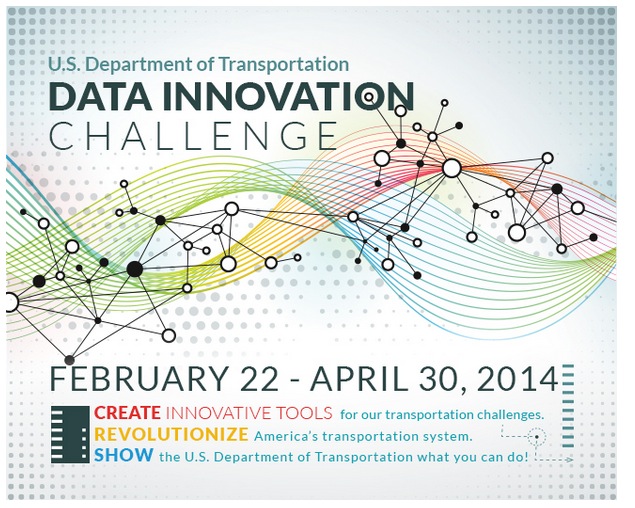
The U.S. Department of Transportation is now accepting entries for their Data Innovation Challenge through April 30, 2014. The challenge is to “create a tool to address systemic challenges by accessing publicly available federal and/or local DOT datasets.” Entrants can choose to create a range of tools, from mobile apps to infographics–the only restriction is that DOT’s publicly available data must be at the core of the project.
View this complete post...The Innovative DOT: A Handbook of Policy and Practice
Wednesday, September 19th, 2012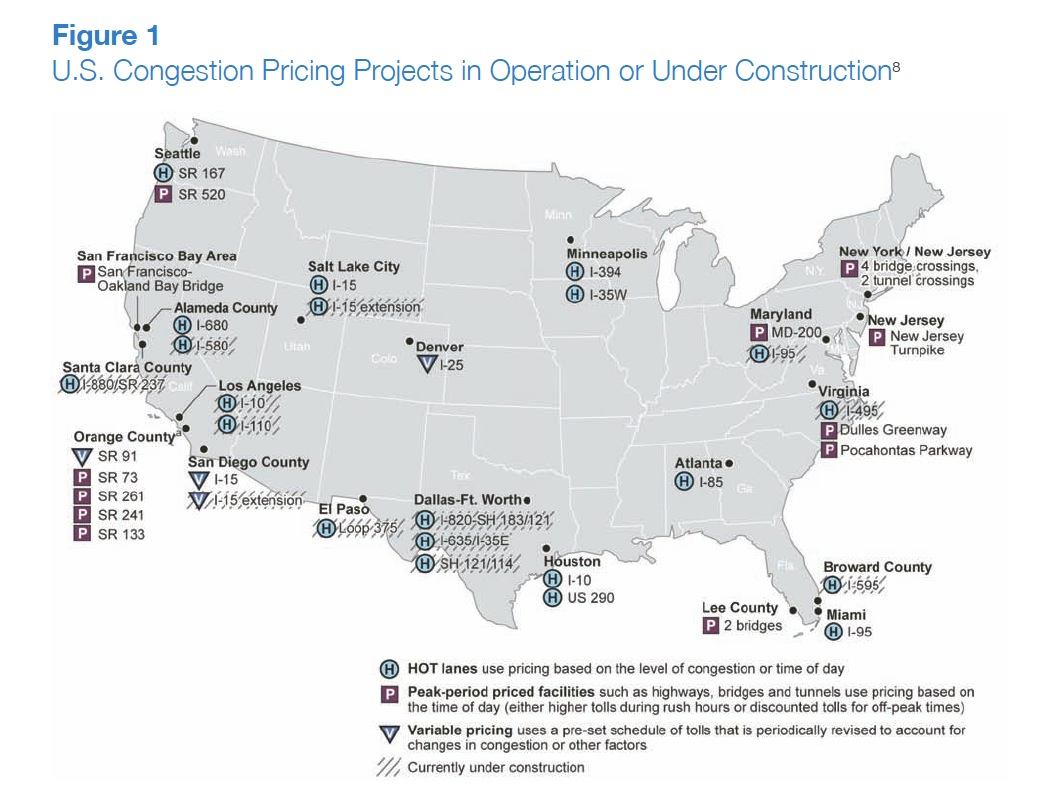
SMART GROWTH AMERICA
State officials across the country are facing the same challenges. Revenues are falling and budgets are shrinking while transportation demands grow. The traditional means of funding and delivering transportation services are no longer adequate, jeopardizing the path to tomorrow’s economy. The only answer is innovation.
Oregon DOT: Readying the EV (Electric Vehicle) Trail
Monday, February 20th, 2012Oregon DOT installing EV charging stations along Interstate 5 and into Central Oregon – OregonDOT on YouTube
View this complete post...Collins-McCaskill Bipartisan Jobs Bill Summary
Tuesday, December 13th, 2011Summary of Plan to Rebuild Nation’s Infrastructure Transportation Funds Funding to Support Transportation Infrastructure. The Collins-McCaskill Bipartisan Jobs Bill would authorize a one-time $10 billion appropriation to capitalize an existing DOT program that help states provide loans, loan guarantees, and other for ms of non-grant assistance which leverage private dollars. States would be required to […]
View this complete post...2010 Sustainable Streets Index
Wednesday, May 11th, 2011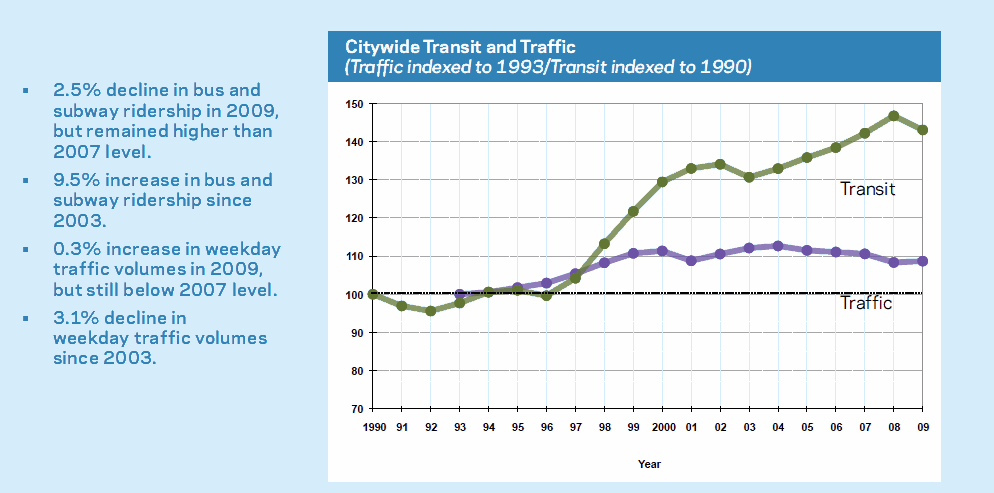
NEW YORK CITY DEPARTMENT OF TRANSPORTATION
Looking beyond the recession, sustainable modes of transportation will likely absorb increased travel generated by economic and population growth – but only if the City and the Metropolitan Transit Authority (MTA) commit the resources to support these modes. The importance of investing in transit and other transportation improvements is illustrated by the two bright spots in the overall picture in the last several years. First, while the bus system as a whole was losing ridership, new Select Bus Services (SBS) in the Bronx and Manhattan attracted increased bus ridership. In a similar vein, continued expansion of the bike network spurred large increases in cycling both into the Manhattan core, and in other areas of the city.
Analysis Of Federal Sustainable Communities Grants
Thursday, November 11th, 2010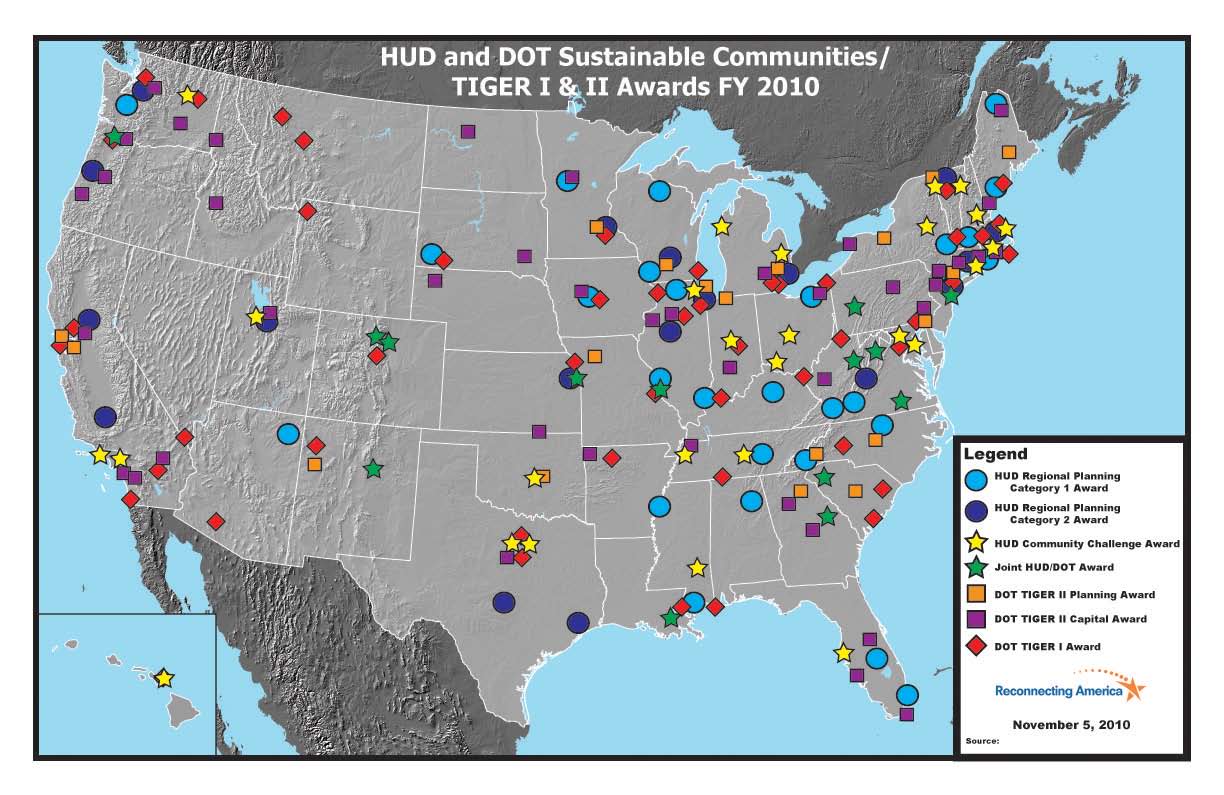
RECONNECTING AMERICA
The past few months have been an exciting time as large and small communities, representing all corners of the country, have worked on developing collaborative planning processes that will address the unique conditions in their region and which will improve the quality of life for the diverse people that live, work and play there…The impetus for this has been competition for grants springing from the unprecedented partnership announced last year between the Department of Housing and Urban Development, the Department of Transportation and the Environmental Protection Agency.
Transportation’s Role in Reducing U.S. Greenhouse Gas Emissions
Thursday, April 29th, 2010
U.S. DEPARTMENT OF TRANSPORTATION
Transportation GHG emissions account for 29 percent of total U.S. GHG emissions, and over 5 percent of global GHG emissions. Except otherwise noted, the estimates in this report account for “tailpipe” emissions from burning fossil fuels to power vehicles and do not account for greenhouse gases emitted
through other transportation lifecycle processes, such as the manufacture of vehicles, the extraction and refining of fuels, and the construction and maintenance of transportation infrastructure.
Follow InfrastructureUSA
CATEGORIES
- Accountability (219)
- Aging Infrastructure (760)
- Aviation (131)
- Biking (324)
- Bipartisan (271)
- Bridges (493)
- Broadband (57)
- Buses (160)
- Carbon Tax (22)
- Clean Air (182)
- Climate Change (202)
- Competitiveness (230)
- Congestion (327)
- Dams (77)
- Democrat (123)
- Drinking Water (193)
- Economic Stimulus (276)
- Employment (207)
- Energy (585)
- Environment (615)
- Equity (239)
- Funding (889)
- Global (205)
- Great American Infrastructure (33)
- Green (295)
- Guests on The Infra Blog (305)
- Hazardous Waste (27)
- High Speed Rail (224)
- Highway (785)
- Inland Waterways (204)
- Jobs (251)
- Land Use (99)
- LEED (28)
- Levees (42)
- Local (1,910)
- National (1,527)
- Policy (1,122)
- Pollution (215)
- Private Investment (213)
- Public Opinion (189)
- Public Parks & Recreation (198)
- Public Transportation (1,028)
- Racism (6)
- Rail (506)
- Recession (65)
- Recovery (218)
- Republican (109)
- Roads (1,120)
- Schools (81)
- Seaports (69)
- Smart Grid (98)
- Smart Growth (442)
- Solid Waste (26)
- Sustainability (767)
- Tax (112)
- Technology (397)
- Telecommunications (46)
- Transit (1,333)
- Urban Planning (984)
- Wastewater (184)
- Water Treatment (169)
Video, stills and tales. Share images of the Infra in your community that demands attention. Post your ideas about national Infra issues. Go ahead. Show Us Your Infra! Upload and instantly share your message.
Is the administration moving fast enough on Infra issues? Are Americans prepared to pay more taxes for repairs? Should job creation be the guiding determination? Vote now!
What do the experts think? This is where the nation's public policy organizations, trade associations and think tanks weigh in with analysis on Infra issues. Tell them what you think. Ask questions. Share a different view.
The Infra Blog offers cutting edge perspective on a broad spectrum of Infra topics. Frequent updates and provocative posts highlight hot button topics -- essential ingredients of a national Infra dialogue.
Dear Friends,
It is encouraging to finally see clear signs of federal action to support a comprehensive US infrastructure investment plan.
Now more than ever, our advocacy is needed to keep stakeholders informed and connected, and to hold politicians to their promises to finally fix our nation’s ailing infrastructure.
We have already engaged nearly 280,000 users, and hoping to add many more as interest continues to grow.
We require your support in order to rise to this occasion, to make the most of this opportunity. Please consider making a tax-deductible donation to InfrastructureUSA.org.
Steve Anderson
Managing Director
SteveAnderson@InfrastructureUSA.org
917-940-7125













 RSS Feed
RSS Feed